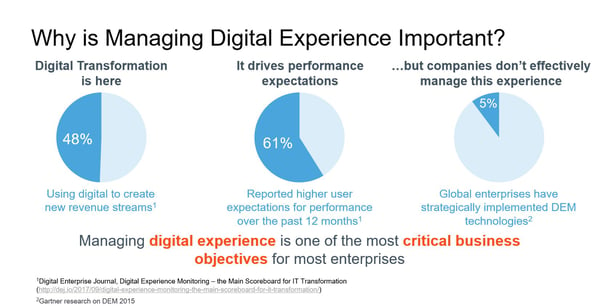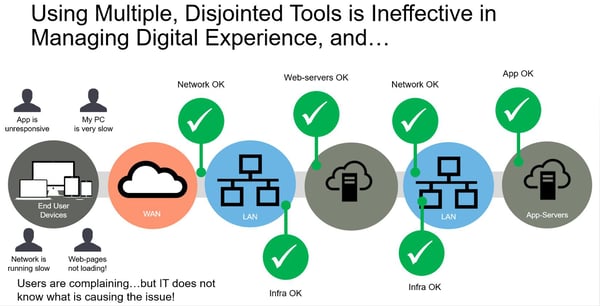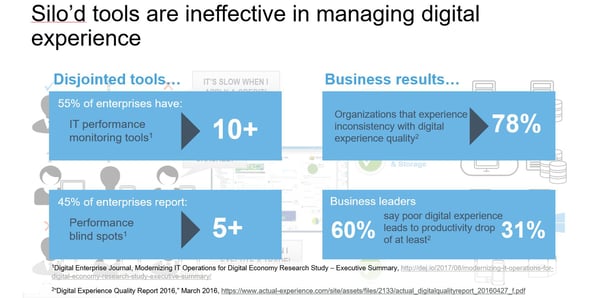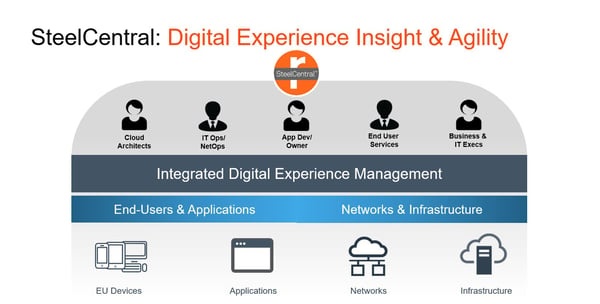
June 14, 2018

We are now living in a world of digital business. Digital technology is a top priority for business leaders, and investing in digital initiatives will continue to grow at an aggressive pace, doubling within three years. Although Digital Transformation is here, most companies do not effectively manage this digital experience.
How does enterprise IT deal with the complexity of managing Digital Experience? Traditionally, IT deployed multiple monitoring tools to monitor each domain. One or more tools to monitor the network, infrastructure, the application, the servers, etc. In this approach you end up with several disjointed tools each separately monitoring each domain, often showing no issues, while the end users still complain of poor application performance. The result is typically a finger pointing situation where each domain lead will claim that their respective area is not causing the issue while the problem remains unresolved.
This approach is ineffective as point solutions are not designed to talk to each other and while they are adequate at monitoring one specific domain, they were never designed to look at the whole system collectively. To quickly identify the root cause of an issue, you need the ability to link several detected events that may not individually identify the problem but collectively point to the cause of the poor performance of the Digital Experience. 

Riverbed® SteelCentral™ is a platform that delivers a complete, modular and integrated Digital Experience Management. Riverbed SteelCentral provides comprehensive monitoring of end-user devices, applications, networks and infrastructure. You can think about SteelCentral as the command center for Digital Experience monitoring that provides broad instrumentation and big data analytics to help holistically manage performance across the hybrid enterprise and manage the digital experience of all users.
Garland Technology provides complete Network Access and Visibility for Riverbed SteelCentral Digital Experience Management platform, through the collection and sending of 100% of the live wire data, while allowing for real-time analysis on data flow, transactions and sessions. The Riverbed and Garland Technology joint solution enables end-to-end visibility to detect and resolve network, application and security performance issues quickly, and improve service performance.
Riverbed SteelCentral network performance monitoring (NPM) solutions provide a complete picture of the health and performance of your network, but monitoring solutions are only as good as the information they receive. Garland Technology’s Network TAPs, Advanced Aggregators and Network Packet Brokers are purpose-built appliances that provide the passive access to data that SteelCentral NPM depends on.
A TAP can fit within any segment of the network and push an exact copy of live network traffic to out-of-band tools in the management network%20(1).png?width=721&name=Riverbed%20-%20Steel%20Central%20TAP%20diagram%20(1)%20(1).png)
In the network drawing above, you can see how the appliances with 10Gb ports can obtain monitor streams from a 40Gb network link, through the use of Garland Technology passive fiber TAPs feeding traffic to the open QSFP+ ports on the 10G Advanced Aggregator. Load balancing and filtering can be used to ensure that the correct network traffic flows to both the SteelCentral AppResponse and SteelCentral NetShark.
[Want to learn more about the Garland Technology and Riverbed partnership? Check out the Riverbed technology partner page for an overview of the current joint solutions.]
If the inline security tool goes off-line, the TAP will bypass the tool and automatically keep the link flowing. The Bypass TAP does this by sending heartbeat packets to the inline security tool. As long as the inline security tool is on-line, the heartbeat packets will be returned to the TAP, and the link traffic will continue to flow through the inline security tool.
If the heartbeat packets are not returned to the TAP (indicating that the inline security tool has gone off-line), the TAP will automatically 'bypass' the inline security tool and keep the link traffic flowing. The TAP also removes the heartbeat packets before sending the network traffic back onto the critical link.
While the TAP is in bypass mode, it continues to send heartbeat packets out to the inline security tool so that once the tool is back on-line, it will begin returning the heartbeat packets back to the TAP indicating that the tool is ready to go back to work. The TAP will then direct the network traffic back through the inline security tool along with the heartbeat packets placing the tool back inline.
Some of you may have noticed a flaw in the logic behind this solution! You say, “What if the TAP should fail because it is also in-line? Then the link will also fail!” The TAP would now be considered a point of failure. That is a good catch – but in our blog on Bypass vs. Failsafe, I explained that if a TAP were to fail or lose power, it must provide failsafe protection to the link it is attached to. So our network TAP will go into Failsafe mode keeping the link flowing.
Single point of failure: a risk to an IT network if one part of the system brings down a larger part of the entire system.
Heartbeat packet: a soft detection technology that monitors the health of inline appliances. Read the heartbeat packet blog here.
Critical link: the connection between two or more network devices or appliances that if the connection fails then the network is disrupted.